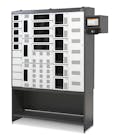Each year, $1 billion worth of tools and building materials are stolen from construction sites.
It would be simple to write these losses off to the cost of doing business, but residential job-site thefts add 2 percent to the price of a new house, according to the National Association of Home Builders.
Someone has to pay, and though some of the burden falls on home buyers, builders and contractors bear the brunt because they have to replace materials and tools and deal with production delays until they do.
Most builders and contractors carry liability insurance. But as with most insurance policies, the more claims you make, the greater the risk of increased premiums or dropped coverage, especially if it seems you've made no serious effort to reduce thefts.
"If you are going to leave your tools on someone's front porch and they're stolen, then it is your fault in the eyes of the insurance company," said contractor Joan Stephens, a contractor in Boise, Idaho, and president of the National Association of the Remodeling Industry.
Theft from construction sites has always been a problem, said Gary Schaal, vice president of sales and marketing for Orleans Homebuilders.
"When I was starting out with another builder years ago, I arrived at a job site as some guys were loading lumber on a truck," Schaal said. "The guy who seemed to be in charge told me that the superintendent had told him to do it. When I asked for the name of the superintendent, he told me that he couldn't remember it.
"I told him to unload the lumber or I'd call the police," Schaal said. "I guess it wasn't very smart of me, since I was outnumbered and far from a phone, but they did it."
Marshal Granor of Granor Price Homes in Horsham said, "Sometimes we hire guards and put up fences, sometimes we don't. It depends on the job and the location."
Once, he said, he discovered that a guard he had hired was working with a neighboring homeowner to pilfer plywood and other lumber products from a job site and store it in the neighbor's garage.
The two men had another guard convinced that it was part of an insurance scam by Granor Price. Granor didn't become aware of the thefts until he tried to fire the naive guard, who "threatened to expose the supposed scam," he said.
"The homeowner didn't think he was doing wrong," echoing the thought that the builder could get its insurance company to pay for the losses, Granor said.
Tools, lumber and appliances are the items most often pilfered from residential construction sites.
"Tools seem to have legs of their own," said Mark Clements of Ambler, editor of Tools of the Trade magazine and a former contractor.
"And the thefts are carried out so quickly," he said. "You go to buy your crew some breakfast sandwiches and the trailer has been emptied of all your tools when you return."
What ruins many smaller contractors is that insurance pays the depreciated value of the tools, not the replacement value, "so you get $20 to replace a $200 tool," he said.
That's what happened to Nik Stajka, an Arlington, Va., contractor who buys, renovates and sells houses in the suburbs near Washington.
"I renovate one house at a time, and I usually rent a 20-foot container to store tools and materials on site," he said.
"I got almost to the end of one job, so I let the container go and decided to store my tools in the basement of the house. One of my guys was working down there and it was dusty, so he opened the windows."
Stajka thinks that either one of the windows didn't close properly or the worker forgot to lock it. The next morning, every tool he owned - $6,200 worth - was gone.
"It doesn't seem like a whole lot of money to some people, but it is a whole lot," he said. "My insurance didn't cover it, and it was a struggle to replace the tools so I could get back to work."
Police, contractors and builders associations are constantly after companies to take precautions at their work sites, such as: hiring reputable security companies to patrol the area at night and on weekends; keeping accurate inventories of what is at the site; limiting access to employees; surrounding the site with chain-link fences at least eight feet high, with limited entry and surveillance cameras; and locking up all equipment in secure storage sheds.
"They need to keep equipment out of view and to make someone responsible for making sure it is," Stephens said.
You can only be so careful, though. Sometimes, employees or subcontractors are stealing the stuff.
DeWalt, the tool manufacturer, has tried in the last couple of years to determine the extent of construction-site thefts.
Using responses from 1,700 contractors and builders across the country, DeWalt found that 97 percent of those surveyed were concerned about security, and that tool theft was the No. 1 concern "because of replacement costs, lost time, and decreased personal productivity."
Since DeWalt's customers are largely building professionals, the company's research and development department began looking into a way to keep tools safe on site.
Its solution was Sitelock, a portable wireless alarm system that consists of a base unit and five sensors. The base station is kept indoors, usually in the job-site trailer, and the remote sensors are placed at strategic points - on big toolboxes and material containers on the site, up to 2,000 feet from the base.
If an intruder tries to disturb the protected equipment or remove a sensor, the alarm is activated and a wireless signal is sent to a monitoring service, said spokesman Bill Pugh.
The base retails for $1,000, and the sensors range from $99 to $199. If the builder chooses, he can use DeWalt's monitoring service for $40 a month, or be notified of a problem immediately by e-mail or cell phone for $30 a month.
Bosch, another major supplier of tools for professional use, is working with ToolWatch Corp. of Englewood, Colo., to install radio-frequency detection devices inside tools at the factory, so their whereabouts can be easily tracked by special computer software.
"It's not only theft that concerns builders and contractors, but inventory control," said Bosch spokesman Jason Feldner. "A builder knows he has 19 reciprocating saws on site, but he forgot where they are. That's what the tool-tracking system is for."
There already is a bar-code system for tracking tools, but according to ToolWatch vice president Joe Caston, the new technology is a major improvement. Tools are embedded with identifying tags that link to such information as serial numbers, purchase date, original price, maintenance schedules and authorized users, he said.
Using a handheld scanner, ToolWatch software records the embedded information. Everyone using a tool passes through a portal at the job site that works the same way as the detectors you walk through entering or leaving stores at the mall.
Embedding the information will add 1 to 2 percent to the cost of the tool, Feldner said.
The cost of job-site theft and preventing it is a line item in a builder's annual budget, Granor said. "I guess we have been lucky. We've only had our model homes broken into twice in 25 years, which is, I think, a good record."
One of those times, the burglar took a tablecloth, a couple of wineglasses, and two place settings.
"We found them nearby, under a tree next to a stream and with a few empty wine bottles," Granor said. "Someone had a picnic."

